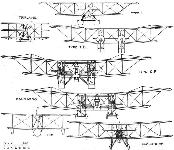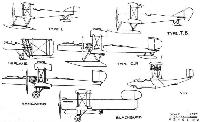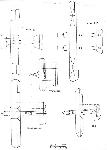A.Jackson Blackburn Aircraft since 1909 (Putnam)
Blackburn N.1B
Designs to an Admiralty requirement for a single-seat fleet escort bomber to replace the Blackburn-built Sopwith Baby seaplane, made known in 1916 as category N.1B, were prepared by the Blackburn Aeroplane and Motor Co Ltd at Leeds, the Supermarine Aviation Works Ltd at Southampton, and the Westland Aircraft Works at Yeovil. Contracts were placed for eight prototypes, three by Blackburn, three by Supermarine and two by Westland. All were known as N.1B, but whereas the Westland machines N16 and N17 were twin-float seaplanes somewhat similar to the Sopwith Baby, the three Supermarines, N59, N60 and N61, were small pusher flying-boats.
The Blackburn N.1B design resembled Supermarine's concept of the requirement in that it too was a pusher flying-boat employing a hull of Linton Hope design. This was built to a system created by Lt Linton Hope, RN, and consisted of circular wooden formers spaced by stringers and planked diagonally with narrow mahogany strips one-eighth of an inch in thickness, in two laminations so that the layers crossed each other at 90 degrees. There the resemblance ended, for the Supermarine boat was constructed on strictly utilitarian lines and had a monoplane tail while the Blackburn N.1B was a sesquiplane of inspired design using a hull of refined and delicate aerodynamic form. Armament was to have been a single Lewis gun mounted on the nose in front of the pilot.
The hand of Harris Booth, who had joined Blackburns from the Air Department of the Admiralty in 1915, can be detected in the design of Blackburn's Machine, not only through general similarity of layout to the early A.D. Flying-Boats (of which the Supermarine N.1B was a descendant), but in minor design features such as the shape of the wing tip floats and the retention of a biplane tail using an inverted RAF14 aerofoil section on the upper tailplane to hold the tail down with engine on if nose heavy and automatically take up a correct gliding angle if the engine failed.
The mainplanes were built round rectangular box spars with two-ply spruce webs and spruce flanges. They were designed to fold to a mean width of 11 ft 2 in, and it is probable that it was intended to have jettisonable wheels for taking-off from the decks of naval vessels.
The two-step hull swept gracefully upwards at the rear, but even so the lower tailplane would have been awash when the aircraft was taxying. It is probable therefore, in the absence of precise details, that this was to have been a watertight plywood structure as on the A.D. Flying-Boats. The ends of all aerofoil surfaces were elliptical, directional control was by twin rudders, and ailerons were fitted to all four wings. Power was supplied by a 200 hp Hispano-Suiza engine, mounted high up under the top centre section, driving a two-bladed, fabric-covered, mahogany airscrew and cooled by a circular radiator mounted in front. Fuel was carried at the C.G. in a midships tank.
Supermarines and Westlands built and flew their prototypes during 1917-18, but successful deck operations by the Sopwith Pup and a promise of an even better performance by its successor the Camel, led to a cancellation of the N.1B contracts in November 1918. Non-availability of the engine slowed down the work of construction at Leeds and, when work ceased, Blackburns had completed only the hull of their first machine N56, and the other two, N57 and N58, existed merely as a number of sub-assemblies.
The completed hull of N56 was put into storage, but was taken out in 1923 and used in the construction of Blackburn's Schneider Trophy entry, the Pellet.
SPECIFICATION AND DATA
Manufacturers: The Blackburn Aeroplane and Motor Co Ltd, Olympia Works, Roundhay Road, Leeds, and Brough Aerodrome, East Yorks.
Power Plant: One 200 hp Hispano-Suiza
Dimensions:
Span (upper) 34 ft 10 in (lower) 29 ft 4 in
Length 28 ft 3 1/2 in Wing area 314 sq It
Weights: Tare weight 1,721 lb All-up weight 2,390 lb
Performance: (Estimated)
Maximum speed 114 mph Climb to 5,000 ft 7 min
Ceiling 16,000 ft Range 340 miles
Production: Hull of N56 only; N57 and N58 incomplete.
G.Duval British Flying-Boats and Amphibians 1909-1952 (Putnam)
Blackburn N.IB (1918)
Designed to the same Air Board Specification as the Supermarine Baby, work commenced on the Blackburn N.1B at the Leeds factory in mid-1918. The hull, of Linton Hope design, was similar to the Baby, being of the usual monocoque construction with external side fins, which extended aft to the main step amidships, and having a small auxiliary step mid-way towards the stern. The bows were longer and more pointed than those of the Baby, however, and the rear part of the hull had a distinctive upward curve towards the stern. The complete machine was to be a single-seat single-bay biplane, the lower mainplane mounted on the hull top and braced from the main step by Vee-struts. A 200 h.p. Hispano-Suiza pusher engine, driving a two-bladed propeller was to be mounted on struts high up in the centre section. The tail unit design was of biplane layout, with twin rudders, the upper plane of inverted camber as on the A.D. Boat and the Supermarine Baby. Large wingtip floats were to be attached directly to the lower wing undersurface. Some difficulties were encountered during hull construction; the American elmwood required was late in delivery, and eventually other woods had to be be used. The hull was then found to require extra stiffening, and eventually, although good progress was made, the coming of the Armistice brought the development to a halt. The completed hull was put into storage. In 1923, an inspection found it still in good condition, and fitted with a new engine and flight structure it was entered for the Schneider Trophy as the Blackburn Pellet.
SPECIFICATION
Power Plant: One 200 h.p. Hispano-Suiza
Span: 34 feet 10 inches
Length: 28 feet 3 1/2 inches
Weight Loaded (estimated): 2,390 pounds
Total Area: 376 square feet
Max. Speed (estimated): 114 m.p.h.
Endurance (estimated): 3 hours
Armament: One free-mounted Lewis gun
Serials Allotted: N56-N58
P.Lewis The British Fighter since 1912 (Putnam)
In the North, the Blackburn Company started in 1917 to construct their N.1B single-seat, flying-boat fighter - also a pusher using the 200 h.p. Hispano-Suiza and of refined aerodynamic form. Progress was slow so that, when the end of the War came, only the hull was ready. Intended armament was a single Lewis gun in front of the pilot.
F.Mason The British Fighter since 1912 (Putnam)
Blackburn N.1B
The Admiralty’s requirement, set out in Specification N.1B, calling for a long-range escort fighter capable of accompanying the large patrol flying boats, prompted the Blackburn Aeroplane company to produce a design to compete with the Supermarine N.1B Baby, which would make its first flight in February 1918. Another contender, which had flown but proved unsuccessful with a speed of only 93 mph, was the Norman Thompson N.1B two-seat flying-boat.
The Blackburn N.1B, designed by Harris Booth - not hitherto renowned for beauty of design - was a remarkably elegant little biplane flying-boat with a span of only 34ft 10in. The hull was designed by Major Linton Hope, with the slightly staggered wings placed above the hull, and the 200hp Hispano-Suiza pusher engine located close up under the upper wing centre section. The pilot’s cockpit was situated forward of the wings with a single Lewis gun in front and offset to starboard, and the gracefully upward-curving rear hull section supporting a biplane tail with twin fins and rudders. Wingtip balancing floats were fitted directly below the interplane struts.
For all the promise shown by the Blackburn design, the Admiralty requirements were changed before the first prototype was completed, and only the hull of N56 had been finished when work on the N.1B was halted. (This hull was incorporated in a post-War aircraft, the Blackburn Pellet, and entered for the 1923 Schneider Trophy race; the aircraft was however destroyed in an accident before the race.)
The accompanying data are design figures only.
Type: Single pusher engine, single-seat biplane flying-boat escort fighter.
Manufacturer: The Blackburn Aeroplane & Motor Co Ltd, Leeds.
Powerplant: One 200hp Hispano-Suiza engine driving two-blade pusher propeller.
Dimensions: Span, 34ft 10in; length, 28ft 3 1/2 in.
Weights: Tare, 1,721lb; all-up, 2,390lb.
Performance: Max speed, 114 mph at sea level; climb to 10,000ft, 18 min; ceiling, 16,000ft; endurance, 3 hr.
Armament: One 0.303in Lewis gun forward of pilot’s cockpit, offset to starboard.
Prototypes: Three ordered, N56-N58; only N56 partly completed.
J.Bruce British Aeroplanes 1914-1918 (Putnam)
Blackburn N.1B
CONSTRUCTION of the Blackburn N.1B began in 1917. It was designed as a single-seat fighter flying boat, and was intended to be used as an escort to the big patrol flying boats. Not unnaturally, the machine was known as the “Nib” in the Blackburn works: its true designation N.1B derived from the number of the Admiralty category to which it was appropriate.
The hull was of Linton Hope design, and its structure was the typical framework of circular wooden hoops and stringers, planked diagonally with strips of mahogany. There were two steps, and the top line of the hull swept upwards slightly to the biplane tail unit. As on the A.D. Flying Boats, the upper tailplane had reversed camber. Both mainplanes and tailplanes were designed to have elliptical tips, and the mainplanes were arranged to fold. The 200 h.p. Hispano-Suiza engine was installed as a pusher under the upper centre-section.
Unfortunately, Service requirements changed while the N.1B was building, and only the hull was completed by the time of the Armistice. This hull was still in excellent condition in 1923, when the Blackburn company decided to enter a machine in the Schneider Trophy contest. It was therefore fitted with biplane wings of sesquiplane configuration and a single-rudder monoplane tail unit. A 450 h.p. Napier Lion engine was installed above the upper wing, and drove a tractor airscrew which revolved in perilous proximity to the pilot’s head.
In this form the machine was named the Blackburn Pellet and was registered G-EBHF. It was to be flown by R. W. Kenworthy in the Schneider Trophy contest at Cowes. When first launched for trials in the Humber the Pellet went down on her starboard wing, turned over slowly, and threw Kenworthy into the river. Salvage, repair and modifications to the wing-tip floats left time for only one test flight on the eve of the race, and during that flight Kenworthy found that the Pellet was nose-heavy. There was no time to correct this fault, but larger Lamblin radiators were installed by all-night work on the part of the Blackburn mechanics: the original radiator was inadequate, and Kenworthy had been forced to alight hurriedly with the water boiling.
The Pellet’s next and last flight was begun as part of the navigability trials which were included in the contest. The machine became airborne at 140 knots, but immediately porpoised badly, turned turtle and sank. Miraculously, Kenworthy survived unhurt.
SPECIFICATION
Manufacturers: The Blackburn Aeroplane & Motor Co., Ltd., Olympia, Leeds.
Power: 200 h.p. Hispano-Suiza.
Dimensions: Span: upper 34 ft 10 in., lower 29 ft 4 in. Length: 28 ft 3 1/2 in. Chord: 5 ft 6 in. Gap: 6 ft 9 in. Stagger: 3. Dihedral: 3. Incidence: 3.
Areas: Wings: upper 170 sq ft, lower 144 sq ft, total 314 sq ft. Ailerons: each 41-5 sq ft, total 83 sq ft. Tailplanes: 30-25 sq ft. Elevators: 21-5 sq ft. Fins: 11 sq ft. Rudders: 9 sq ft.
Weights: Empty: 1,721 lb. Loaded: 2,390 lb.
Performance (Estimated): Maximum speed at sea level: 114 m.p.h.; at 10,000 ft: 108 m.p.h. Climb to 5,000 ft: 7 min; to 10,000 ft: 18 min. Ceiling: 16,000 ft. Endurance: 3 hours.
Armament: One forward-firing Lewis machine-gun mounted above the hull in front of the cockpit, to starboard of centre.
Serial Numbers: N.56-N.58.
Журнал Flight
Flight, December 11, 1919.
"MILESTONES"
THE BLACKBURN MACHINES.
The "N1b" Flying Boat
The next machine to be laid down was a seaplane of the flying boat type, known as the "N1b." Owing to certain changes in Service requirements this machine was not actually completed, although we understand that both design and construction were nearly finished. It will therefore be understood that the figures of performance, etc., are estimated ones. The "N1b" was intended to act as escort to our large bombing flying boats.








